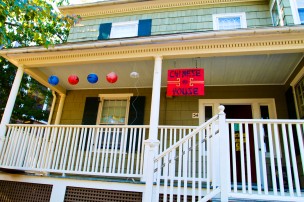Spicy foods: whether you like them or not, they provide a considerably more exciting gustatory experience than grabbing dinner at Usdan at half past five on a drab Tuesday evening. Far more goes into preparing spicy food than slathering a dish with Tabasco or Sriracha, and the experience transcends simple consumption. There is the smell of dried chili, the sweat of determined faces, the red-nose sniffles, and the oh-so-rewarding prospect of milk at the end of your hot meal.
Fortunately, Chinese House’s Spicy Food Contest had each of these elements.
Held on Friday, Sept. 27, the competition was Chinese House’s first house event this academic year. The chief architect of the event was House Manager Lynn Ma ’16, who could be seen promptly seating all eager competitors in the lounge. The rules were simple: the dishes would get spicier, and anyone who finished all of the dishes without drinking milk was a winner.
Contestants were given a simple yet sumptuously crafted blend of pho noodles, chicken, and meat, all branded with the fiery red mark of chili. Equally spicy vegetarian versions of each dish were also available. Contestants ate from plastic plates, as they waited for the next batch of food to be presented.
Meanwhile, in the kitchen, a group of residents mixed the ingredients and engineered the spice. With a quick glance around, one could see four near-empty jars of chili flakes, crimson chili, teriyaki, and soy sauce. The residents, or makeshift chefs, could be seen occasionally dipping their chopsticks into the blend as they inspected the hotness of the dish, increasing the spiciness accordingly.
But, for all of these added flavors, the real secret behind the spice can be attributed to the nature of pho noodles. Unlike regular pho—essentially a Vietnamese noodle dish served with broth—soup-less pho noodles are more akin to Pad Thai. Pho noodles soaked in oil cook faster. When spices are added to the mix, the noodles soak in the spice along with the oil. Add some herbs, a dab of pepper, and some vegetables or chicken, and the result is a zesty dish. The residents also added soy sauce, teriyaki sauce, and occasionally an entire chili. Most of the seasonings were bought from an Asian supermarket in West Hartford.
Back in the lounge, contestants were beginning to show signs of trouble as the barrage of spicy dishes burned their tongues. Some contestants seemed near tears, while others struggled to appear unfazed. Many people had red faces and were gasping. Everybody was smiling, though, seemingly proud of braving the ordeal. As contestants emptied their plates, the organizers brought in the next batch of dishes.
One of the most evident effects of the heat was the contestants’ decreased ability to speak.
“It’s pretty spicy,” said Jay Sharma ’16, when asked about his experience of participating in the competition.
Others disagreed with this characterization of the spiciness.
“I don’t consider myself a spicy food connoisseur, but I wasn’t dying,” said Willie Zabar ’16.
The one flaw in the competition was the initial lack of vegetarian food. The first dishes brought out all contained meat, although a show of hands proved that a significant portion of the participants were vegetarian.
The competition was meant to promote awareness of Chinese House. Participation in the competition was impressive: the lounge was packed, the hosts expressed surprise at the turnout, and there was not enough milk to go around. The competition bridged Eastern cuisines with hungry Wesleyan mouths and helped Chinese House to become one of the hottest tickets around.

Comments are closed